Yun-Hsuan Sung
Dr Genre: Reinforcement Learning from Decoupled LLM Feedback for Generic Text Rewriting
Mar 09, 2025Abstract:Generic text rewriting is a prevalent large language model (LLM) application that covers diverse real-world tasks, such as style transfer, fact correction, and email editing. These tasks vary in rewriting objectives (e.g., factual consistency vs. semantic preservation), making it challenging to develop a unified model that excels across all dimensions. Existing methods often specialize in either a single task or a specific objective, limiting their generalizability. In this work, we introduce a generic model proficient in factuality, stylistic, and conversational rewriting tasks. To simulate real-world user rewrite requests, we construct a conversational rewrite dataset, ChatRewrite, that presents ``natural''-sounding instructions, from raw emails using LLMs. Combined with other popular rewrite datasets, including LongFact for the factuality rewrite task and RewriteLM for the stylistic rewrite task, this forms a broad benchmark for training and evaluating generic rewrite models. To align with task-specific objectives, we propose Dr Genre, a Decoupled-reward learning framework for Generic rewriting, that utilizes objective-oriented reward models with a task-specific weighting. Evaluation shows that \approach delivers higher-quality rewrites across all targeted tasks, improving objectives including instruction following (agreement), internal consistency (coherence), and minimal unnecessary edits (conciseness).
Foundational Autoraters: Taming Large Language Models for Better Automatic Evaluation
Jul 15, 2024Abstract:As large language models (LLMs) advance, it becomes more challenging to reliably evaluate their output due to the high costs of human evaluation. To make progress towards better LLM autoraters, we introduce FLAMe, a family of Foundational Large Autorater Models. FLAMe is trained on our large and diverse collection of 100+ quality assessment tasks comprising 5M+ human judgments, curated and standardized using publicly released human evaluations from previous research. FLAMe significantly improves generalization to a wide variety of held-out tasks, outperforming LLMs trained on proprietary data like GPT-4 and Claude-3 on many tasks. We show that FLAMe can also serve as a powerful starting point for further downstream fine-tuning, using reward modeling evaluation as a case study (FLAMe-RM). Notably, on RewardBench, our FLAMe-RM-24B model (with an accuracy of 87.8%) is the top-performing generative model trained exclusively on permissively licensed data, outperforming both GPT-4-0125 (85.9%) and GPT-4o (84.7%). Additionally, we explore a more computationally efficient approach using a novel tail-patch fine-tuning strategy to optimize our FLAMe multitask mixture for reward modeling evaluation (FLAMe-Opt-RM), offering competitive RewardBench performance while requiring approximately 25x less training datapoints. Overall, our FLAMe variants outperform all popular proprietary LLM-as-a-Judge models we consider across 8 out of 12 autorater evaluation benchmarks, encompassing 53 quality assessment tasks, including RewardBench and LLM-AggreFact. Finally, our analysis reveals that FLAMe is significantly less biased than these LLM-as-a-Judge models on the CoBBLEr autorater bias benchmark, while effectively identifying high-quality responses for code generation.
Characterizing Tradeoffs in Language Model Decoding with Informational Interpretations
Nov 16, 2023Abstract:We propose a theoretical framework for formulating language model decoder algorithms with dynamic programming and information theory. With dynamic programming, we lift the design of decoder algorithms from the logit space to the action-state value function space, and show that the decoding algorithms are consequences of optimizing the action-state value functions. Each component in the action-state value function space has an information theoretical interpretation. With the lifting and interpretation, it becomes evident what the decoder algorithm is optimized for, and hence facilitating the arbitration of the tradeoffs in sensibleness, diversity, and attribution.
FreshLLMs: Refreshing Large Language Models with Search Engine Augmentation
Oct 05, 2023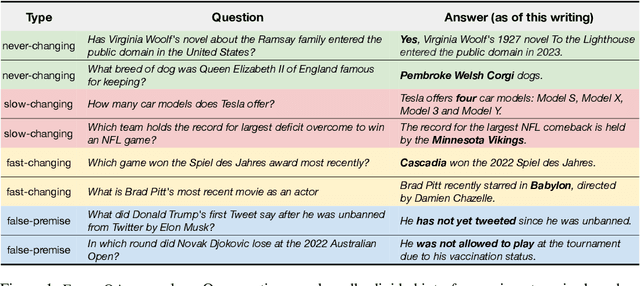



Abstract:Most large language models (LLMs) are trained once and never updated; thus, they lack the ability to dynamically adapt to our ever-changing world. In this work, we perform a detailed study of the factuality of LLM-generated text in the context of answering questions that test current world knowledge. Specifically, we introduce FreshQA, a novel dynamic QA benchmark encompassing a diverse range of question and answer types, including questions that require fast-changing world knowledge as well as questions with false premises that need to be debunked. We benchmark a diverse array of both closed and open-source LLMs under a two-mode evaluation procedure that allows us to measure both correctness and hallucination. Through human evaluations involving more than 50K judgments, we shed light on limitations of these models and demonstrate significant room for improvement: for instance, all models (regardless of model size) struggle on questions that involve fast-changing knowledge and false premises. Motivated by these results, we present FreshPrompt, a simple few-shot prompting method that substantially boosts the performance of an LLM on FreshQA by incorporating relevant and up-to-date information retrieved from a search engine into the prompt. Our experiments show that FreshPrompt outperforms both competing search engine-augmented prompting methods such as Self-Ask (Press et al., 2022) as well as commercial systems such as Perplexity.AI. Further analysis of FreshPrompt reveals that both the number of retrieved evidences and their order play a key role in influencing the correctness of LLM-generated answers. Additionally, instructing the LLM to generate concise and direct answers helps reduce hallucination compared to encouraging more verbose answers. To facilitate future work, we release FreshQA at github.com/freshllms/freshqa and commit to updating it at regular intervals.
KL-Divergence Guided Temperature Sampling
Jun 02, 2023Abstract:Temperature sampling is a conventional approach to diversify large language model predictions. As temperature increases, the prediction becomes diverse but also vulnerable to hallucinations -- generating tokens that are sensible but not factual. One common approach to mitigate hallucinations is to provide source/grounding documents and the model is trained to produce predictions that bind to and are attributable to the provided source. It appears that there is a trade-off between diversity and attribution. To mitigate any such trade-off, we propose to relax the constraint of having a fixed temperature over decoding steps, and a mechanism to guide the dynamic temperature according to its relevance to the source through KL-divergence. Our experiments justifies the trade-off, and shows that our sampling algorithm outperforms the conventional top-k and top-p algorithms in conversational question-answering and summarization tasks.
CoLT5: Faster Long-Range Transformers with Conditional Computation
Mar 17, 2023Abstract:Many natural language processing tasks benefit from long inputs, but processing long documents with Transformers is expensive -- not only due to quadratic attention complexity but also from applying feedforward and projection layers to every token. However, not all tokens are equally important, especially for longer documents. We propose CoLT5, a long-input Transformer model that builds on this intuition by employing conditional computation, devoting more resources to important tokens in both feedforward and attention layers. We show that CoLT5 achieves stronger performance than LongT5 with much faster training and inference, achieving SOTA on the long-input SCROLLS benchmark. Moreover, CoLT5 can effectively and tractably make use of extremely long inputs, showing strong gains up to 64k input length.
LongT5: Efficient Text-To-Text Transformer for Long Sequences
Dec 15, 2021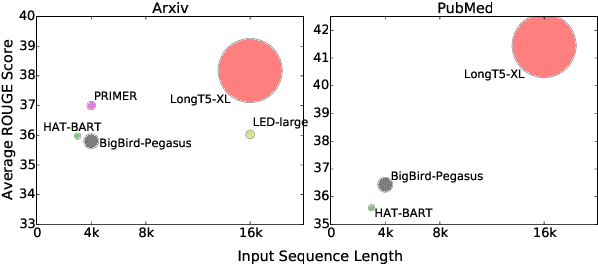

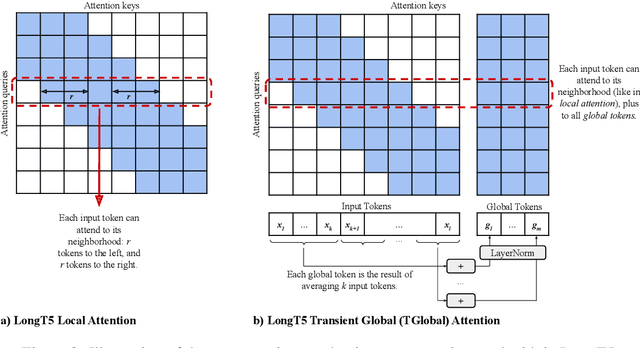
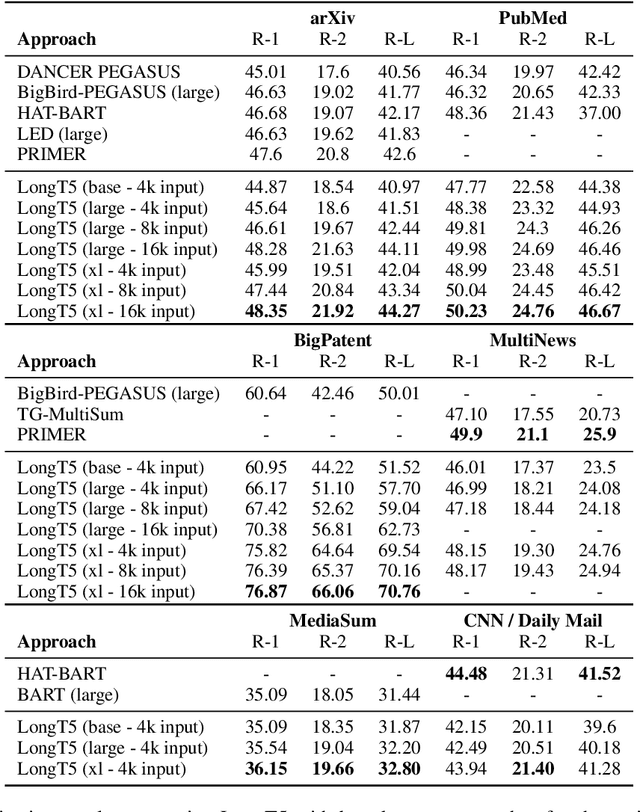
Abstract:Recent work has shown that either (1) increasing the input length or (2) increasing model size can improve the performance of Transformer-based neural models. In this paper, we present a new model, called LongT5, with which we explore the effects of scaling both the input length and model size at the same time. Specifically, we integrated attention ideas from long-input transformers (ETC), and adopted pre-training strategies from summarization pre-training (PEGASUS) into the scalable T5 architecture. The result is a new attention mechanism we call {\em Transient Global} (TGlobal), which mimics ETC's local/global attention mechanism, but without requiring additional side-inputs. We are able to achieve state-of-the-art results on several summarization tasks and outperform the original T5 models on question answering tasks.
Multilingual Universal Sentence Encoder for Semantic Retrieval
Jul 09, 2019Abstract:We introduce two pre-trained retrieval focused multilingual sentence encoding models, respectively based on the Transformer and CNN model architectures. The models embed text from 16 languages into a single semantic space using a multi-task trained dual-encoder that learns tied representations using translation based bridge tasks (Chidambaram al., 2018). The models provide performance that is competitive with the state-of-the-art on: semantic retrieval (SR), translation pair bitext retrieval (BR) and retrieval question answering (ReQA). On English transfer learning tasks, our sentence-level embeddings approach, and in some cases exceed, the performance of monolingual, English only, sentence embedding models. Our models are made available for download on TensorFlow Hub.
Hierarchical Document Encoder for Parallel Corpus Mining
Jun 30, 2019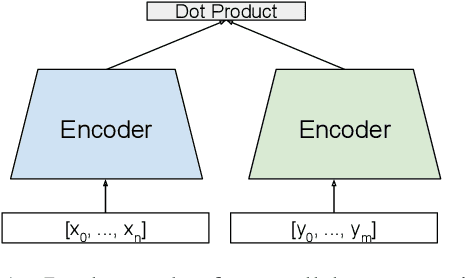
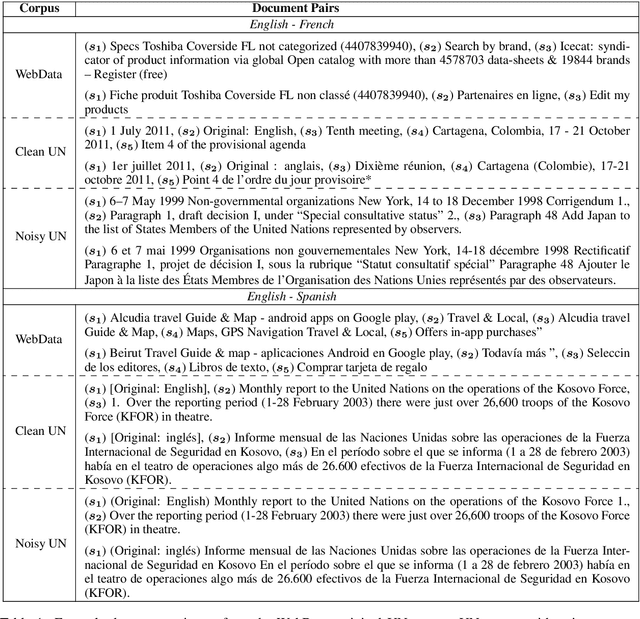


Abstract:We explore using multilingual document embeddings for nearest neighbor mining of parallel data. Three document-level representations are investigated: (i) document embeddings generated by simply averaging multilingual sentence embeddings; (ii) a neural bag-of-words (BoW) document encoding model; (iii) a hierarchical multilingual document encoder (HiDE) that builds on our sentence-level model. The results show document embeddings derived from sentence-level averaging are surprisingly effective for clean datasets, but suggest models trained hierarchically at the document-level are more effective on noisy data. Analysis experiments demonstrate our hierarchical models are very robust to variations in the underlying sentence embedding quality. Using document embeddings trained with HiDE achieves state-of-the-art performance on United Nations (UN) parallel document mining, 94.9% P@1 for en-fr and 97.3% P@1 for en-es.
Learning Cross-Lingual Sentence Representations via a Multi-task Dual-Encoder Model
Oct 30, 2018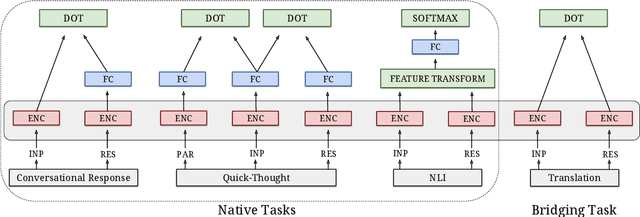
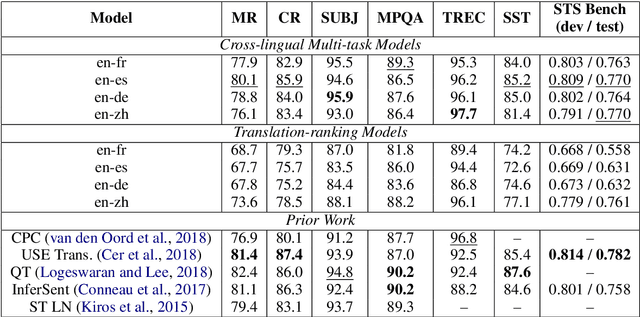

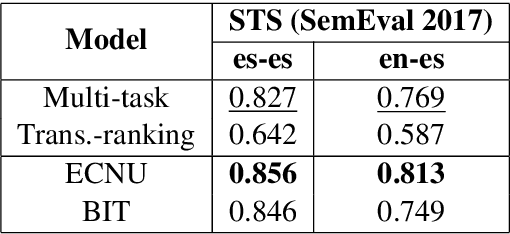
Abstract:Neural language models have been shown to achieve an impressive level of performance on a number of language processing tasks. The majority of these models, however, are limited to producing predictions for only English texts due to limited amounts of labeled data available in other languages. One potential method for overcoming this issue is learning cross-lingual text representations that can be used to transfer the performance from training on English tasks to non-English tasks, despite little to no task-specific non-English data. In this paper, we explore a natural setup for learning cross-lingual sentence representations: the dual-encoder. We provide a comprehensive evaluation of our cross-lingual representations on a number of monolingual, cross-lingual, and zero-shot/few-shot learning tasks, and also give an analysis of different learned cross-lingual embedding spaces.
 Add to Chrome
Add to Chrome Add to Firefox
Add to Firefox Add to Edge
Add to Edge